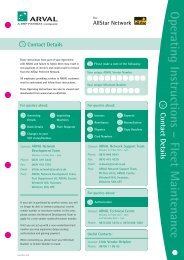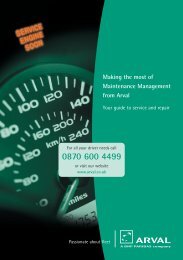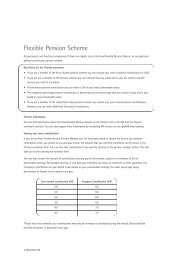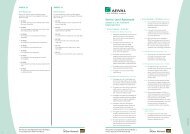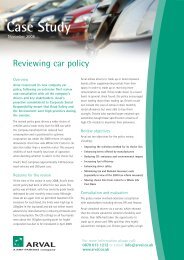Directions - Arval
Directions - Arval
Directions - Arval
You also want an ePaper? Increase the reach of your titles
YUMPU automatically turns print PDFs into web optimized ePapers that Google loves.
<strong>Directions</strong><br />
August 2008 | Managers<br />
Driving in Europe this summer?<br />
( )<br />
We all look forward to the summer holidays,<br />
and if you are thinking about driving your<br />
car in Europe the following information will<br />
help you to be prepared.<br />
It is important to remember that each country's<br />
motoring laws, regulations and advice is subject<br />
to constant review, change and differing<br />
interpretations – visit www.theaa.com for the<br />
latest information.<br />
You also need to bear in mind that the enforcement<br />
of motoring laws abroad can be more severe than in<br />
the UK. Very large on the spot fines can be imposed<br />
in some countries, so make sure that you comply<br />
with sign posted speed limits and ensure everyone<br />
in the car is wearing a seat belt. Some countries<br />
may also vary speed limits depending on weather<br />
conditions. If you are involved in an accident<br />
resulting in damage, it is worth calling the police, if<br />
anybody is hurt you must call them.<br />
Documents you will need<br />
You may be asked to produce the following<br />
documents at any time. To avoid a police fine<br />
and/or confiscation of your vehicle, be sure that<br />
they are in order and readily available for inspection.<br />
– A valid full driving licence (not provisional), with<br />
paper counterpart if you have a photo card licence<br />
– An International Driving Permit when necessary<br />
– The original Vehicle Registration Document (V5)<br />
or a Vehicle on Hire Certificate (VE103 see later)<br />
– Your motor insurance certificate – contact your<br />
insurer for advice at least a month before<br />
travelling to ensure you are adequately covered<br />
and have the necessary documents to prove it<br />
– Your passport<br />
Obtaining your VE103 from <strong>Arval</strong><br />
If your vehicle is leased from <strong>Arval</strong> we hold the V5,<br />
which means that you need a VE103, the recognised<br />
alternative to the V5. This also covers you whilst<br />
proceeding to, and returning from, the port of<br />
embarkation. It is valid for a year from the date of<br />
issue and will cover you for all your foreign travel<br />
within that year. There is a charge of £7.50 + VAT<br />
per certificate. Your company policy dictates how<br />
we charge for this but in general this is charged to<br />
your credit or switch card. The address used for the<br />
For more information please call:<br />
0870 013 1212 or email: info@arval.co.uk<br />
www.arval.co.uk
VE103 must legally be the 'custodians' home address<br />
and must match the address on your driving license.<br />
Visit <strong>Arval</strong> Online and go to Tools and Information<br />
or contact the Driver Contact Centre on 0870 600<br />
4499 to request an Overseas Pack.<br />
Do not risk travelling without a VE103. In a recent high<br />
profile case a vehicle without a VE103 was impounded<br />
for four days while the original copy of the V5 was<br />
mailed out to the local police station. The driver had a<br />
letter of authority with him but this was not accepted.<br />
General information for you<br />
and your passengers<br />
Breakdown cover – make sure that you have<br />
adequate cover for driving in European countries.<br />
Security – never leave handbags and other attractive<br />
items in obvious view even when you are in the car,<br />
and never leave anything in an unattended car. For<br />
advice on car crime or personal safety in specific<br />
countries, contact the Foreign Office Travel Advice<br />
Unit on 0845 850 2829 or visit www.fco.gov.uk<br />
Drinking and driving – there is only one safe rule<br />
– if you drink, do not drive. Laws are strict and<br />
the penalties are severe.<br />
Children in Cars – rules relating to the age and<br />
height of children that can be carried as front seat<br />
passengers vary by country so check before you leave.<br />
Mobile phones – the use of hand-held mobile<br />
phones while driving is prohibited in many countries.<br />
Spectacles – take a spare pair of spectacles or<br />
contact lenses if you wear them – especially if you<br />
are the sole driver.<br />
Think right – it is easy to forget to drive on the<br />
right, particularly after doing something familiar,<br />
such as leaving a petrol station or car park.<br />
Your car<br />
When travelling on the continent you must ensure<br />
that you comply with European motoring<br />
regulations by carrying the following items of<br />
equipment, which are required by law in many<br />
countries and are advisable in any case.<br />
GB sticker – compulsory – failure to comply could<br />
result in an on-the-spot fine.<br />
Euro-plates – number plates that include the GB<br />
euro-symbol have been legal since March 2001 and<br />
make display of a conventional sticker unnecessary<br />
within the EU. In some countries outside the EU a<br />
conventional sticker is required even if you have<br />
euro-plates, so it is always safer to display one.<br />
Reflective jacket/waistcoat – this is compulsory<br />
when visiting Italy, Spain, Portugal, Austria, Croatia<br />
and France. The AA recommends each vehicle carry<br />
at least two jackets/waistcoats in the passenger<br />
compartment – one for the driver and one for a<br />
passenger who may need to assist e.g. with changing<br />
a wheel. In an emergency the jacket must be easily<br />
accessible by the driver and must be put on before<br />
leaving the car. The Jacket/waistcoat must conform<br />
to EU Standard BS EN 471:1994 Class 1 or 2.<br />
Speed-trap detection devices – the use or<br />
possession of devices to detect police radar is illegal<br />
in most European countries. Penalties can include a<br />
fine, driving ban and even imprisonment.<br />
Tyres – like the UK, most countries require a<br />
minimum tread depth of 1.6mm over the central<br />
three-quarters of the tread and around the whole<br />
circumference. <strong>Arval</strong> recommends a minimum of<br />
2mm but consider changing tyres if the tread is<br />
down to 3mm before you travel. Tyres wear out<br />
quickly after they get down to 3mm.<br />
Headlights – if you are driving to the Continent<br />
you must adjust the headlamp beam pattern to suit<br />
driving on the right so the dipped beam will not<br />
dazzle oncoming drivers. Never go without adjusting<br />
the headlamp pattern, as it is a compulsory<br />
requirement in most countries. Failure to adapt your<br />
headlamps will render your vehicle unfit for use on<br />
the road and will invalidate your motor insurance.<br />
Headlamp beam converter kits are widely available<br />
but do not leave headlamp conversion to the last<br />
minute, as a dealer may need to make the<br />
adjustment for you*. Remember to remove the<br />
converters when you return to the UK.<br />
* Particularly if you have hid or xenon headlights.
Warning triangle – this is compulsory in the<br />
majority of countries to give advance warning of a<br />
hazard on the road. Hazard warning lights alone are<br />
NOT sufficient in many European countries.<br />
Overloading – do not overload the car as, safety<br />
risks apart, this can incur fines and possibly<br />
invalidate insurance. Remember, carrying five cases<br />
of wine is equivalent to having another passenger in<br />
the car. If you overload your car you could pay more<br />
in repair bills than you saved on your shopping.<br />
Overloading can cause damage to suspension, burnt<br />
out clutch, punctures or uneven wear on tyres.<br />
Make sure that you service your car well in advance<br />
to reduce the chance of expensive breakdowns<br />
when abroad.<br />
For more information visit the AA website at<br />
www.theaa.co.uk<br />
Have a good holiday!
Driving Requirements for Travelling in Europe<br />
Driving requirements Austria Belgium Switzerland Germany Spain France Portugal Italy Netherlands Sweden Denmark Norway Ireland<br />
17<br />
18 18 18 18 18 18 17 (8) 17 18 18 17 17 (8)<br />
Minimum age at which a<br />
visitor may drive a car/(UK<br />
licence holders)<br />
NO<br />
NO (1) NO NO NO NO (2) NO NO (2) NO (2) NO NO (1) NO NO<br />
International Driving<br />
Permit required for UK<br />
licence holders (IDP)<br />
TOLLS<br />
TOLLS<br />
C & TOLLS NO C & TOLLS NO TOLLS TOLLS TOLLS TOLLS NO TOLLS TOLLS<br />
Motorway Tax<br />
C<br />
C*<br />
C* C* C* R (3) C* (4) C (5) R (5) C (5) R* (5) R C<br />
Warning Triangle<br />
n/a<br />
C* C (6) n/a n/a C* (6) C R (6) C (6) n/a n/a n/a n/a<br />
Reflective Jacket/<br />
Waistcoat<br />
NO<br />
C R (12) NO R NO NO NO NO NO R R R<br />
First Aid Kit<br />
NO<br />
NO R (12) NO NO NO NO NO NO NO R R R<br />
Fire Extinguisher*<br />
NO<br />
C C C C C C C C C C C C<br />
Headlamp Adjustment (11)<br />
YES<br />
YES YES YES YES YES YES YES YES (7) YES YES (7) YES YES<br />
On The Spot Fines<br />
R<br />
R<br />
C<br />
C<br />
C<br />
C<br />
C<br />
C<br />
R<br />
R<br />
C (9)<br />
C<br />
NO (10)<br />
C<br />
R<br />
C<br />
NO<br />
C<br />
R(10)<br />
R<br />
R<br />
R<br />
NO<br />
C<br />
R<br />
R<br />
Daytime headlights/<br />
Passing Lights<br />
• Cars<br />
• Motorcycles<br />
The Original Registration Document and Motor Vehicle Insurance is required for driving in all of the above countries. Before taking a vehicle abroad contact your motor insurer or broker to notify them of your intentions, and ask their<br />
advice. It is important to know what level of cover you will have and what documents you need to prove it.<br />
C = Compulsory R = Recommended by AA/respective Country (*Not required for motorcycles)<br />
Source: AA
Notes<br />
(1) UK driving licences without a photograph are<br />
recognised but, drivers must be able to produce<br />
photographic proof of identity (e.g. passport).<br />
(2) All valid UK licences should be accepted, this<br />
cannot be guaranteed on older green style<br />
licences. Drivers may wish to update them<br />
before travelling abroad. Alternatively, older<br />
licences may be accompanied by an IDP.<br />
(3) Although not compulsory for visiting motorists<br />
to carry a warning triangle, its use is<br />
compulsory in an accident/breakdown situation.<br />
(4) One warning triangle is compulsory for non-<br />
Spanish registered vehicles; two for Spanish<br />
registered vehicles. Drivers of non-Spanish<br />
registered vehicles should consider carrying<br />
two triangles as, regardless of regulations, local<br />
officials may impose on-the-spot fine if only<br />
one is available.<br />
(5) Use of hazard warning lights or warning<br />
triangle is compulsory in an accident or<br />
breakdown situation. A warning triangle should<br />
always be carried as hazard-warning lights<br />
have no effect at bends or rises in the road, or<br />
may become damaged or inoperative.<br />
(6) Compulsory to wear if driver and/or passengers<br />
exit vehicle immobilised on carriageway, in<br />
Italy at night or in poor visibility, in Spain on<br />
motorways and busy roads. In Portugal, this<br />
applies to Portuguese residents; however,<br />
regardless of the regulations local officials may<br />
impose on-the-spot fines. In Belgium wearing<br />
of a reflective jacket only applies to the driver,<br />
it must be worn if you are stranded on a<br />
motorway or a major road or if you stop at a<br />
place where parking is not allowed.<br />
(7) Sweden: Police are not authorised to actually<br />
collect fines, which must be paid in accordance<br />
with notice instructions. Italy: Police will<br />
collect a quarter of the maximum fine amount<br />
from drivers of foreign registered vehicles.<br />
(8) Norway: 18 for Norwegian registered vehicles.<br />
Portugal: Visiting drivers aged 17 may<br />
encounter problems even though they hold a<br />
valid driving licence in the UK.<br />
(9) Outside built up areas.<br />
(10) Compulsory during daylight hours if the<br />
visibility is poor.<br />
(11) On some cars it is inadvisable for anyone other<br />
than a qualified technician to change a<br />
headlamp bulb unit e.g. high intensity<br />
discharge (HID) headlamps, and carrying spares<br />
is not an option. Spare bulbs should be carried<br />
for lights that are easy for the driver to<br />
change. Spare bulbs and tools to change lights<br />
required in Spain. Headlamp adjustment for<br />
older vehicles can be done by using simple<br />
adhesive masks on the headlamp glass. For<br />
newer vehicles with HID, Zenon or Halogen<br />
headlamps it is not easy. Check what you must<br />
do before your departure by contacting a<br />
dealer for your make of vehicle. In some<br />
countries it is compulsory to use dipped<br />
headlights when driving during the day. This<br />
adjustment is not required for motorcycles as<br />
the beam is more symmetrical, but check extra<br />
loading has not affected the beam height.<br />
(12) Recommended, as their carriage is compulsory<br />
for Belgium registered vehicles.<br />
Source: AA<br />
For more information please call:<br />
0870 013 1212 or email: info@arval.co.uk<br />
www.arval.co.uk WH.13310.07/08



